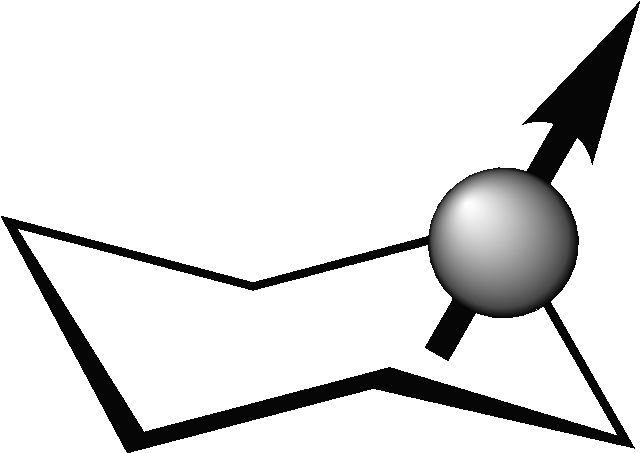Instructions
In addition to these instructions there is also a more verbose
manual.
- General introduction
- Sequence determination
- Assignment of the spectrum of a known structure
- Supported residues
Recording of NMR spectra
NMR spectra should be recorded in D
2O at 70°
and referenced against acetone (
1H 2.225 ppm,
13C 31.07 ppm) or 1,4-dioxane (
13C 67.40 ppm).
If a different reference has been used it may be necessary to correct
the measured chemical shifts by subtraction of an offset.
This is done by entering the correction in the field close to the
chemical shifts. Differences in solvent or temperature are normally
small (except for aromatic solvents,
e.g. pyridine-
d5)
and difficult to predict. If there is a large systematic error in the
simulated spectrum
this may be used as an approximate correction. However, this error
depends on the structure from which it is taken and might not become zero
after the first correction if an incomplete spectrum was used.
Introduction
For a sequence determination You will require the results from
a sugar (component) analysis, methylation (linkage) analysis and an NMR
spectrum. The NMR data is entered manually in the form.
Step-by-step
- Select residues from the pull-down menus.
Note that some residues,
such as methyl glycosides, are only available from the first menu.
- Check the linkage positions.
Some positions will not be available
for certain sugars.
- Select 13C or 1H depending on data.
- Enter the chemical shifts either in the text-area. The chemical shifts should be separated by spaces and/or linefeeds.
- To save
the content of the form first press the
Save form button. You will now be able to download a form with
all your selections as default values.
Saving the filled-in form straight away will only result in a copy of the
blank form.
- Press Start simulation
Examples:
dextran,
a Shigella LPS,
a Xylose containing N-glycan.
There is help available for the different elements of the form. This help is toggled on and off by pressing the ?-marks.
Step-by-step
- Select the appropriate residues. For a homopolymer a single residue
may be sufficient but it must be selected from the first
or last residue
menu and linked using the self option.
Note that some residues,
such as methyl glycosides, are only available from the first menu.
- Choose the anomeric configurations.
- For each residue select the linkage type and the residue to
which it is attached.
Note that only residues on the first or last menu may be linked
to them selves.
- Enter the 1H and 13C chemical shifts to be
assigned (not required).
- To save
the content of the form first press the
Save form button. You will now be able to download a form with
all your selections as default values.
Saving the filled-in form straight away will only result in a copy of the
blank form.
- Press Start simulation
Examples:
Methyl b-D-cellobioside.
There is help available for the different elements of the form. This help is toggled on and off by pressing the ?-marks.
Appendix
| Residue |
|
Symbol |
| Arabino-hexose |
3,6-dideoxy-D- |
Tyvp (Tyvelose) |
| Arabino-hexose |
3,6-dideoxy-L- |
Ascp (Ascarylose) |
| Ribo-hexose |
3,6-dideoxy-D- |
Parp (Paratose) |
| Xylo-hexose |
3,6-dideoxy-D- |
Abep (Abequose) |
| Xylo-hexose |
3,6-dideoxy-L- |
Colp (Colitose) |
| Abequose |
|
Abep |
| Ascarylose |
|
Ascp |
| Colitose |
|
Colp |
| Fucopyranose |
D- |
D-Fucp |
| Fucopyranose |
L- |
L-Fucp |
| Galactopyranose |
2-acetamido-2-deoxy-D- |
D-GalpNAc |
| Galactopyranose |
6-deoxy-D- |
D-Fucp (Fucose) |
| Galactopyranose |
6-deoxy-L- |
L-Fucp (Fucose) |
| Galactopyranose |
D- |
D-Galp |
| Galactopyranosiduronate |
D- |
D-GalpA |
| Glucopyranose |
2-acetamido-2-deoxy-D- |
D-GlcpNAc |
| Glucopyranose |
6-deoxy-D- |
D-Quip (Quinovose) |
| Glucopyranose |
D- |
D-Glcp |
| Glucopyranosiduronate |
D- |
D-GlcpA |
| Mannopyranose |
2-acetamido-2-deoxy-D- |
D-ManpNAc |
| Mannopyranose |
6-deoxy-D- |
D-Rhap (Rhamnose) |
| Mannopyranose |
6-deoxy-L- |
L-Rhap (Rhamnose) |
| Mannopyranose |
D- |
D-Manp |
| Mannopyranosiduronate |
D- |
D-ManpA |
| Muramic acid |
|
MurNAc |
| Paratose |
|
Parp |
| Quinovose |
D- |
D-Quip |
| Rhamnopyranose |
D- |
D-Rhap |
| Rhamnopyranose |
L- |
L-Rhap |
| Tyvelose |
|
Tyvp |
|

